Podcast: Play in new window | Download
How to Start Eco Friendly Landscaping – Show Notes
Today’s links: ely.how/episode106
-
Sign up for the webinar on July 9 2020 “5 Easy Steps to an Eco Friendly Yard”
- Members Jen & Gary – Awesome example of Eco Friendly Landscaping
- Join the “I Help Save The Earth” Club
- How to create a Rain Garden
- How to Xeriscape (Drought Tolerant Landscaping)
- Impactful books by Doug Tallamy:
- Bringing Nature Home – Why native plants are important to you
- Nature’s Best Hope – Why your backyard can save the world
- You can always Ask Ben a Question for Free!
- Are you ready to make a difference? Create the yard you deserve in the ELY Membership!
How to get started with Eco Friendly Landscaping!
- Reduce Chemical Use
- Reduce both synthetic herbicide and pesticide use
- Non-target effects
- Improve health of
- you
- your family
- your pets
- your landscape
- Critters
- the WORLD
- Water Management
- Reduce irrigation frequency
- Use drought tolerant plants
- Increase absorption
- Create rain gardens for infiltration
- Provide Habitat
- Make your home a home for others
- Welcome nature into your landscape
- enjoyment
- education
- species survival
- Choose native plants first
- Let your garden get a bit untidy in winter
- Reduce Gas Emissions
- Reduce frequency
- Go electric
- Reduce Lawn and Hardscape
- Buffer climate
- Sequester carbon
- Reduce runoff
- Recharge aquifers
How to Start Eco Friendly Landscaping ELY 106
00:00:00 – 00:05:00
What’s up? I’m Ben Hale and this is the easy living yards podcast. Creating Beautiful Yard should be easy. Let’s jump in create the Dream Yard. You deserve so you can enjoy more time doing what you love. Welcome to episode one hundred
six and the easy living yards podcast today. We’re going to talk about how to get started with ECO friendly landscaping. Guys. This is an awesome show today as usual of course right, but today we’re talking about how you can get started
with your landscape you wherever you’re at right now. What can you do to be more? Eco Friendly with your landscape. Today more than ever. This is super important that our yards serve a greater purpose not just to look beautiful, not to
just be a space to relax inner to play in, but also to provide a space for those other members of our world. That’s what today’s show is about. This has been a theme, and it will continue to be a theme with the direction of where easy
living are going. I believe we should all have a beautiful eco-friendly landscape and eco-friendly landscape means something that were well. We’ll get into today of course, but in a nut show not to be a formal definition. This is
something where we shouldn’t be using a ton of inputs whether that’s our time. Our Labor or synthetically produced amendments or fossil fuels whatever it is, we should reduce our inputs in our landscapes. In the outputs of our
landscapes, the joy we get from them, and also the benefit to the natural world around us. That’s what ego friendly landscaping is to me, and that’s what I hope. You aspire to have with your landscape as well. So we’re going to go
through a couple, things I’ll just break out the buckets right now. We’re going to talk about chemical. Use Water, use habitat, gas, emissions and reducing lawns and hard skate. Have a ton of awesome links for today’s show. I also want
to share before we jump into this topic that I’m going to be offering a free. Webinar on July ninth twenty twenty, so this is Thursday July ninth. It’s coming up soon after this show airs, so if available a highly recommend you jump on
and sign up to this webinar over to easy living yards dot com slash Eko webinar. We’re GONNA. Be Talking about five easy steps to eco-friendly yard. This is a perfect compliment to today’s show so today. We’re kind of talking about the.
Overarching ways to get started and we’re going to get super specific on steps. You can take in this free. Webinar so if you WANNA go over to easy living yards dot com slash echo webinar sign up July ninth I think we’re planning. On
Eight. Thirty PM eastern time might be nine PM. Eastern time stuff to lockdown the time, but it’s going to be in the evening eastern time. Easy living yards dot. COM SLASH ecowebinar. guys go over and check out. I look forward to talking
with you guys. It’s going to be a live session with Acuna the end as well so any questions you have, you can ask me directly. We’re GONNA. Have a lot of fun chitchat about. ECO friendly landscaping all right. Let’s jump in today’s show.
So I when it comes to getting started with EKO friendly landscaping. One of the first things I always talk about is chemical use. We’ve become so dependent on. Inputs chemical inputs into our landscapes. Guys are landscapes. They’re not
a chemistry process. There at minimum of biochemistry process right and more importantly their giant habitat in ecosphere. Just because we’re giant macro organisms we. So easily gloss over the immense amount of activity that goes on. We
can’t see in our landscapes. There’s an immense amount or minced potential for a huge amount of. Micro, Biota, and microbiological processes and I’m not just talking about bacteria, but I’m also talking about. Fungal Processes
Protozoans, all sorts of these crazy alien, looking creatures that do very very per provide very very important functions in our landscapes in in a well-functioning Habitat. Are Chemical Use is actually a sign of disease. If you think
about it. A perfect analogy is is the medical industry right? If you’re dependent on a lot of medications likely it’s a sign that your body is not working properly right, and yes, I get it. Sometimes, there’s very.
00:05:01 – 00:10:16
There things where you need to take medication right, but usually it’s a sign of a deeper problem right so so if we can fix the problem. In a healthier way than we don’t need that medicine while they’re landscape are very similar. Okay
so often. We reached to bottle of Weed & feed to put around our landscape or Roundup to deal with a weed problem right or Some pesticides brandon insect. Or over entire area if we have an insect problem. To treat our whole lawn for grubs
right? This is a problem. And we’re not dealing with it in the healthiest way. These chemicals have non-target effects. They. They affect basically other creatures that we don’t realize it might not even be in our immediate landscape.
There’s a significant amount of what the environmental protection. Agency calls non point source pollution that comes from homeowners landscapes. Basically we apply these chemicals to our landscapes, and then it rains before these
chemicals are fully degraded. Into, sometimes. Just is unhealthy components. And they’re washed down the drain into the sewer into our waterways where they can be very. Detrimental to aquatic habitats, they can also soak into aquifers.
If. You don’t want Aquifer is. Take, a look at what’s coming out of your tap when you turn it on. A lot of our water comes from underground systems and. We’re contaminating with with all these chemicals that we use on our landscapes. So,
there are a lot of non target effects both to humans and to a vast array of life around us when we use these chemicals. Yes, they’re convenient. Yes, they’re easier right when you’re talking about a specific problem, but if we can Weiner
selves off of these chemicals, the long-term benefit is actually much greater. Both to ourselves and to the world around US sometimes. It means we do have to sacrifice a little bit. A perfect example is in our front landscape. It’s It’s
looking beautiful this year by the way, so it’s about two years old now our front foundation landscape. We redid and. It’s mostly native plants. and. Four specific plans are these beautiful astor’s. It’s a it’s a cultivar called Purple
Dome. And so it’s a Cultivar of native plant and these Purple Dome Astor’s. They look amazing in the fall. They’re Nice, compact shrub e. form of a herb Asia’s perennial, so they die back to the ground each year well this year they came
up and they started to get infested with some sort of insect, and so I was looking into more about this insect in for more I can tell it’s the chrysanthemum lace bug. The Chrysanthemum Lace bug affects various related flowers and plants
in the. Composite Family which is composite flowers, such as chrysanthemums and asters and so anyway. Trying to be true to my intent of reducing chemical use, and and also even furthermore being non interventionist. I wanted to
experiment and see what happened. Well, it turns out. These plants go fully infested. They die back to the ground and two of them are completely dead to appear to be bouncing back so. I! Don’t necessarily mean work without intervention
here. What I mean is to reduce our dependence on synthetic herbicides and pesticides. Okay, there are other interventions. So for example with these lace bugs a simple intervention, because the larva are not very mobile. is to simply
spray off the plants when you see a larger infestation going on as long as a significant portion of the plant can survive after these insects complete their life cycles and move on You’ll be okay, but if you let it go completely as I,
did with my front yard experiment You may be dealing with more disastrous consequences. Of course, a longer term thing is to also provide habitat for beneficial insects in predatory insects. We’ll get to that a little bit right, okay? So
as far as chemical use goes right, let’s try and reduce it, and you can use other interventions so like this spring for water for for things like aphids, and all these soft bodied insects. These lace bugs that I was dealing with. Things
like Japanese beetles. If they’re really bothering your plants I go around. We have some poetries in the back and. They for whatever reason these Japanese beetles seem to like the paltry surprisingly and so I’ll go around maybe about
once a week in the peak of summer when they’re really getting bad and I just go around and find him in them into a couple of soapy water.
00:10:16 – 00:15:01
It takes care of him. I don’t have to spray anything. It’s very. Non. Doesn’t have a broad effect like spraying a chemical on the tree where the plants can eat it and die, because then any any use. Zebra swallowtail caterpillars that
come on and use Paw Paws as a host plant, they might die as well and I don’t want that I. Don’t know about you guys but I like swallowtail butterflies I actually like a lot of insects. Yes, sometimes they can cause problems, but overall
there good partner to have in the world, and let’s remember some of our favorite things. eat plants and insects. To. To grow into something that’s useful for humans to. All right, so I think we’ve talked enough about chemicals. The the
biggest thing is whatever you’re doing now. See if you can do a little bit less okay. And just work toward the goal of eventually getting off of using synthetic chemicals in what maybe is a healthy natural alternative or practice. To
what you currently do. Of course, there’s a lot of details here, but that’s the overarching thing for lawns. Think about what you can do for organic lawn care practice. With your plants think what you can do if you need to intervene. To
to not you have to use chemicals to do so. All right, let’s move on. So we talked about reducing chemical use. Let’s talk about water use, and here is not necessarily just reducing water use, but being conscious of the water that affects
our landscape and the water. We put into our landscape. Okay, so it’s more about conscious use of water. Here’s the reality. Guys, no matter where you live in the United States. We’re living unstressed water resources wherever you live
in the world. You’re likely also living on stressed watery sources. Of course we think about water resources from the standpoint of freshwater use, and for the use of humans. So We also have to think about sharing it with the world
around us. Of course, right? The water cycle is a whole freshwater systems for freshwater habitat. But then also sustainable freshwater use for human use okay. So when it comes to our landscapes, also think about what we use freshwater
for right. We use it for drinking. We use it for agriculture very important things for sustaining of human life right so there are many more important things than watering rose bushes. That water needs to be used for. Also. It’s likely
that potable water does not need to be used in your landscapes about that, too. I’m not going to get into grey water systems here, but you can always consider grey water reuse in your landscape is one way to consciously increase the
usefulness of freshwater so grey water reuse in a nutshell if you’re not familiar with the concept is where you take water from your household that is been used once for something most commonly with laundry washing for example. And then
it’s re purposed into a lower tier use. That does not need to be as purified such as landscape period. This is awesome way to repurpose water instead of just sending it down the train, and and using it for you know whether it’s rinsing
off a plate and a bowl, and then going down the drain or something right or washing your dirty clothes, and then going down the drain. Think about how much water gets used their. Rates so these are practices. We can put in place things
such as grey water reuse. Yes, this requires some work, but I want to put the bug in your ear now. Just in case you WANNA consider in the future. What else can we do well? Let’s talk about irrigation right if you irrigate your landscape.
Are you doing it efficiently? Are you doing it properly? Can you change your habits just to be more conscious? So for example With irradiation system is it on a timer? Does it always need to operate when the timer going most likely not
okay and also generally speaking, it’s better to water less frequently and more deeply. To help develop stronger more robust plants than it is to water more frequently and less deeply if that makes sense, so think about how you can
change Your Era Gatien habits to also be more conscious with the water you’re using. What about the plans themselves? Perhaps we can change the plants we have in our landscape that aren’t as thirsty and don’t require as much water use,
and then can be more conscious about the water.
00:15:01 – 00:20:06
We need to use now if you have a new landscape. Here’s reality a lot of plants especially after transplant. They need a little help. Getting started right. They need a little nursing to get going, and so you might need to do some short-
term irrigation for that and that you know that’s a little bit more acceptable, because in the long term you developing a more robust system that’s going to be hardier and the long-term. Okay so I hope you guys get that. I want to
highlight a couple. More things one is increasing absorption. So with increasing absorption, what I mean here is is. Most landscapes are designed to get water off them as quickly as possible to get them away from the foundation of the
House, which is an important thing for the structural integrity of your home, but not only away from the house, but is off of your landscape as quickly as possible. But think about what you can do with that water right if you can let it
sit in your landscape. A couple more days. What could they do for your landscape? I’m not necessarily talking about giant pools of water sitting here and there right. Maybe you have problems with that for one right. What I’m talking
about, here’s how to design your landscape to retain water a little bit. Soak it into the ground where it’s held in the soil. And can then be used by plants and the critters in your soil that are important for healthy soil life. A great
example is rain gardens for example. So of course I want to highlight I just talked about. Rain Gardens in episode seventy seven, so go over to easy living yards dot com slash episode seventy seven to learn more about rain garden design
there. I’ll have a link to this. In many other resources in the show notes over it. Easy living yards dot com slash episode one zero six, so. For now, just keep listening for later. Check on all these awesome resources that I’ll be
talking about. The next resource. Comes right after this, which is a I, didn’t episode on zero escaping and drought tolerant plants. So that’s easy. Living yards dot com slash episodes seventy four check that one out so basically drought
tolerant lancers. Are Selecting drought. Tolerant plants is an awesome way to provide beauty in your landscape. You know not just to have a barren landscape provide beauty with plants that thrive in drought conditions. There are tons of
plants that are well adapted to really tough conditions select those plants for the conditions you have. In order to have a better healthier lower maintenance landscape, the requires less work from you and less environmental inputs. So
go on, check it out zero escaping episode seventy four over it easy living yards dot com slash episode seventy four. All right so next up. We’re going to talk about providing habitat. Providing Habitat. Will our homes our habitat right
well? I’m talking about everything else in the world. Not You and your family hepatitis, really important guys at talked about in past shows how basically our backyards can become like the new National Park System, right? It’s necessary
and funny enough. I’ve talked about this here. This this big guy called Doug. Ptolemy is saying basically the same thing with his latest book out, so he calls it I think homegrown national parks. Well, he’s onto a great idea here. Right
and the reason. Doug talks about homegrown national parks, and I talk about the the new National Park System in our backyards is because. Having nature you know. Sheltered off in some fragmented piece of park preserve. Somewhere Isn’t
good enough there. We’ve reduced the amount of natural habitat, not only United States, but across the world to such a small proportion that that the natural world is in a drastically disastrous state. It’s on the precipice of mass
extinction. We’re in the middle of mass extinctions. Guys I don’t mean this show to be incredibly negative. or you know scary is probably a better word. I’m not trying to use scare tactics here, but the reality is. This is scary, guys.
This is really scary. It scares me a lot. And so I really encourage you to read some of Doug’s books. He has to great books specifically that I want to highlight. So Doug Ptolemy rates the book bringing nature home, which provides an
awesome case for why native plants are important. And his more recent book. Nature’s best hope just is awesome to all right, so so bringing nature home really talks about the importance of native plants and plants. You can select a new
yards and ones that are super You know how much they support insect life, which is important for all other levels of life, basically to is his case.
00:20:07 – 00:25:00
And then nature’s best hope provides an incredibly compelling case as why our backyards are the place that this should happen, so I can’t agree with Doug more here I. Want you to check out his books. They’re awesome Maybe one day I’ll
have doug on the show here. That would be awesome to to tell you in his own words where you don’t have to read them right. That’d be pretty cool too so. Check those out, but but basically our home. Should be healthy space, not only for
us, and for our children and our pets, but also the world around us right. The greater landscape is I sometimes. Call it, too. So, what’s this new national park system will basically. We don’t have to be separate from nature. We can be
integrated with nature and it can be beautiful. So you’re landscape can be designed in a way that’s as aesthetically pleasing to whatever kind of condition you know style, you have with the appropriate plants that can also provide
habitat for insects, and for macro fauna, right so for rabbits, and and chipmunks in you know all. Peregrine Falcons, maybe you know. Maybe show up one day. Your landscape to whatever it is right. You’re providing a positive impact with
your landscape instead of being a native impact. That’s the important thing is, and that’s what habitat does. That’s what all of these things I’m talking about today. Do all right. I can’t be more passionate about this. Okay, so our
landscapes have to serve a positive purpose I believe that strongly and hope you believe that, too. So how can you provide that positive purpose with your? Your landscape well, we talk about a lot of things right. I’ve talked about
saving time. That’s important because your time is valuable. That’s a limited resource of your life. Right so saving. Time’s really important. I’ve talked a lot about that will today’s not about that piece all right? Today is about
providing a positive benefit to leave behind a positive legacy that you’re landscape can leave behind to the world around us. The reality is you’re landscape used to be a more healthy habitat than it is now. Right most of us that live
east of the Mississippi I can. That’s the case. West of the Mississippi I can guarantee that you’re. Landscape is a higher resource drain than it ever was in the past before it was developed okay. Those are blanket statements. I would
say they’re ninety nine percent true. So how can we reverse that right? How can we make up for the damage that we’ve done by being here on this earth by existing and by having a home right? Those are all important things because we
wouldn’t be here without them right. So how can we make them the best possible? How can we make that postage-stamp? postage-stamp lot into a postage stamp national park right okay in something. That’s also beautiful. That’s something
your neighbors admire and want to emulate right something that your kids can go out and experience their own National Park Right. They can experience the wild nature. Right in your backyard and your front yard. Okay, so that’s what
habitat does so. How do you do that well I. WE WE WANNA start with that overarching goal. Make your home a home for other creatures right? And how do we do that? Well? Of course, one of the biggest things is turned in native plants. I
okay. Turning to native plants. Native creatures are. Especially native urban mayors right are adapted to native plants right the. He, that’s what they’ve evolved to eat over millennia right, and even even native omnivores or native
carnivores are adapted to native plants. Birds have been documented to nest. and to be able to evade predators better in specific native plants compared to non native plants all right in other parts of the world does not native plants
are native right and they’re. They’re adapted to that local ecosystem, but here things are different all right so wherever you are. Wherever here is for you and wherever there is for their right? Think about what’s native to your
landscape in the US, it’s it’s potentially a lot easier to do. Because the United States for better for worse was more recently developed than a lot of other parts of the world, and we still have a lot of native fragments left. They’re
not necessarily untouched. They’re not necessarily pristine, but there are a lot of more pockets of native habitat, so let’s. Take that one step further backward as far as ecological damage goes. And provide a beautiful enjoyable native.
00:25:01 – 00:30:00
For the animals and plants around US okay. This is about species protection guys, not only the insects and the animals, but also the plants themselves. To protecting that genetic biodiversity that comes with native habitats. Okay so
turns a native plants I right. That’s important for variety habitat. Leave areas that are. Less, frequently tended. They don’t have to be uglier scrubby, but just let them take care of themselves and don’t get in there and intervene so
much right, so this means you know. Her flowerbed doesn’t have to be pulled at the end of the season, right? You don’t have to pull up all the plants all those routes and stuff if it’s an annual bed. Let them go over the winter, right.
So a lot of insects over winter in dead plant, material and dead plant material can be very attractive in its own right to. Another piece here is. What you do with your lawn matters. Okay, and I’m talking about how much lawn you have and
how you manage it, so this ties into the other points right chemical uses very important. Frequency of mowing is very important. So mowing less frequently, mowing higher actually provides better habitat for more insects in you landscape,
and provides healthier grasses well okay, and then of course reducing one, which is a later point teasing into it right, but it’s also important and replacing some of that lawn with something more valuable. Right trees guys I. Don’t know
about you, but I love trees. I think they’re beautiful. Selecting a few native trees that are also beautiful to go in your landscape are also very beneficial for your landscape. Okay, and not only for you, but for your habitat that
you’re providing so do a good turn right? Do something good with your landscape plant. Some natives plants a beautiful plants, okay. Let’s talk about gas emissions all right. I. Don’t know about you, but almost every single day where we
live, we hear the roar of two cycle engine and a four cycle engine not on a car. I’m talking about lawn mowers and weed eaters and blowers. They’re going all the time in the warmer months. Okay, it’s crazy. It’s hard for me to recording
sometimes because they’re so loud even indoors. It’s hard to record. Okay, that’s how it is well. Reduce your emissions or less frequently. Raise your more bit higher. Your grass will go slower. Your routes were developed better on your
grass. You’ll your grass will? So you’ll have to mow less often because you grass growing is growing slower. Yes, it’s a little bit taller, but it still looks pretty guys when you trim it, and all those blades are nice, and even just as
even when your grass is taller and you Presley cut it as if you had your motor blades lower. Okay, so it looks beautiful. You know it still looks like a lawn. Okay, and you don’t have to Mos often. You’re reducing your gas emissions
there. Of course, reducing lawn would also reduce your gas emissions just a little teaser here of course. Now, another option of course is going electric now. This is potentially controversial because if you using battery-powered. MOWER
which is way more convenient than accorded more I will be hundred percent. Honest there, so if you’re using a battery powered more, there’s a huge environmental impact of lithium my. Lithium mining as well as other trace minerals
required for for a lot of those electric battery powered instruments. So you know there’s a contentious debate there and rightfully so because there’s a huge environmental impact with that lithium mining. On the flipside. Greatly reduces
gas emissions when you switch to electric, so it’s consider that at least and. We just gotTa get. A battery powered MOWER this past year and a really. We couldn’t be happier with it it. It lasts for essentially our whole landscape when
we mow it. On one battery charge, and it’s super quiet or kids can talk to us while we’re mowing if they inevitably interrupt even if we ask them, you know to go stay out back while I cut the grass it’s it’s not the reality. Let’s face
it right. But we don’t have to turn off the MOWER every time. It’s so quiet When our neighbors are mowing at the same time, they’re mowers lower wilder than the one right in front of us, so that’s. Very nice benefit as well. But we’re
talking about gas emissions, so think of what you can do to reduce your gas, emissions, mowers and weed trimmers and blowers. Those small engines are more. I don’t have the statistics here. I purposely did not gather statistics for
today’s show because there’s a lot of nuance there as well right, but.
00:30:01 – 00:35:00
But they’re more. Destructive in their emissions, then cars are. It’s crazy. Right so, but if you think about pretty much everybody with a lawn has lawnmower and. Those mowers, those tremors. This blowers belch out. All sorts of
hydrocarbons into our atmosphere that causes all sorts of problems that’s well documented whether or not you agree with all the whatever sign of clients climate scientists you WanNa believe in. Or whatever it’s well documented.
Hydrocarbons in the atmosphere are not good, and it happens a lot. Okay, so let’s leave it at that. So reduce your gas emissions. Let’s move onto the last piece. Reduce your lawns in heart scape okay. We’ve substantially increase the
amount of impervious or not very pervious surfaces in the United States, and in the world as a whole. What’s pervious? It means permeable. Maybe that’s should use. Maybe I should use less fancy word okay out of the fancy, Word Club.
Impermeable and semi permeable surfaces all right there. We go so basically surfaces where water if it falls on it, it’s sheets off instead of soaking it all right naturally. Water is supposed to soak into the landscape almost as much or
more than it runs off the landscape. This is healthy for the soil. It’s healthy for the aquifer underneath it, which again is where we get our drinking water. Andy or Gatien water from for the most of the world all right so. Those
systems aren’t being replenished as quickly as they’re being deplenished, is that a word deplenished diminished there? We go man. It’s fancy word day. Guys are all right. I didn’t know we were GONNA use many fancy words all right so
basically by reducing your lawn handier hard scape right an increasing amount of surfaces that infiltrate water. Into permeable, they would go permeable services they help buffer climate, help sequester carbon they reduce. Run off again.
Check out that Rain Garden Design Episode Episode Seventy seven over it. Easy living yards dot com slash episode seventy seven, and of course these things recharge aquifers, which is a big problem. I’ve talked about right so all of these
measures. Really, that’s what they do buffering climate. What do I mean well? When you cover surfaces like like concrete or lawns that you know aren’t very good at buffering climate, you know. They get hot in summer cold in the Winter
Wendy when it’s windy, right? That’s what I’m talking about. They get dry when the sun’s out and wet when the rains out, but not for long okay, so what we want is for them to stay white a lot longer as they soak in the water. We want
them to not get as hot. When the sun’s out. When we went to knock it as cold when it’s winter and we went to not get as Wendy when it’s Wendy that’s buffering. So, so buffering climates really important all of these measures we’ve talked
about today. Help with increasing habitat creating that backyard national park. What is Doug? Call it again. The homegrown national park right so I guess I need to start using his term because I think he’s bigger and more important than
me, okay? Let’s face it. We’re going to stick with my term because I’m a punk. BUFFERING, climate! Increasing Habitat, all of these measures go to do that, and let’s face it from a selfish standpoint. It makes it feel good right. You’re
making a difference. We all WanNa make a positive difference. That’s the reality right so why not make a positive difference with your landscape? These are ways you can do it again. If you guys want to get super detailed on ways, you can
start today. I have that. Follow up, Webinar coming up. July ninth twenty, twenty eight thirty PM. That’s Thursday. Five easy steps eco-friendly yard. We’re going to get super granular on what to do now to get started and you I. I.
Challenge you to pick one of these five steps talk about to. Commit to making a difference within the next week. Right so July ninth. Come join me, I’ll be live talking with you is face to face will. Digital face to face right. That’s
Israel’s gets these days with covid life. Right so digital to face A. we’ll have a live Q. and at the end so you can ask me your questions. We can talk about stuff. Talk about stuff that’s fun so going over to easy living yards dot com
slash ego Webinar to sign up today all right, get your spot on that Webinar. Make sure you have a spot. July ninth at eight thirty, PM Eastern. Okay all these all these guys. All these links had talked about today there. Let me spit it
out I’m having trouble getting things out today I. Guess a little bit. Thanks for bearing with me. I hope are super psyched about this show. When I get excited. It’s pretty obvious I.
00:35:00 – 00:36:33
think so links for today’s show I didn’t talk about it, but just recently episode one zero four ahead. easy living yards, members Jenin Gary on. On to talk about their landscape and all the awesome work they’re doing because they’re rock
starring it. Okay. They’re doing awesome stuff with their yard to create a beautiful yard that’s filled with eco-friendly habitat for all sorts of creatures. Okay, it’s awesome. It’s gone over. If you haven’t heard that show going over
to easy living yards dot com slash episode one zero four. If you guys WanNa, hear me get even more passionate about stuff. And to join the club with me going over to, he’s living yards. Dot Com slash episode eighty-seven where I talk
about. My Save the Earth Club all right. It’s a little tongue in cheek. There, it’s a club. I started in fourth grade. It was awesome. It’s still awesome and today’s show easy. Easy living yards is my manifestation of the Save the Earth
Club so by you being a listener I think you’re kind of like. You know. You’re semi inaugurated into I. Help Save the Earth Club going over to that show and pledged to be a member with me there. You can be an honorary member. Now rain
gardens, episodes, seventy, seven, zero, escaping episode seventy four. All these links in the show notes guys going over sign up to the Webinar. I look forward to talking with you. and. I think we’ll leave it at that right. Okay. Thanks
for tuning in. Make sure you live with passion. Make tomorrow better than today.
You deserve a beautiful yard!
Easy Living Yards can help you create your beautiful eco-friendly yard.
See below to find the options right for you. Start today!
Note: Some of the links on this page contain affiliate links. If you click on these links to make a purchase, I may obtain a small commission at no charge to you. All of these products are either products I own or have researched and would like to own. You can read my full affiliate disclosure here.




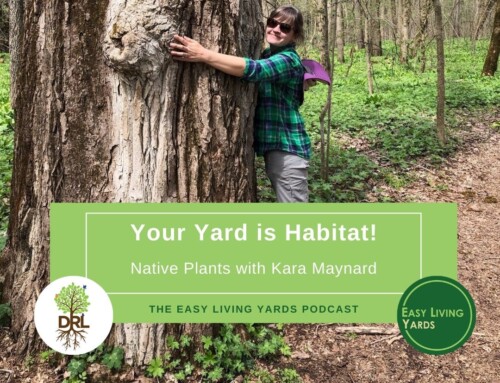
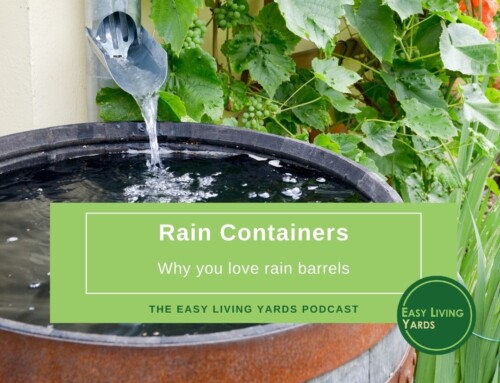
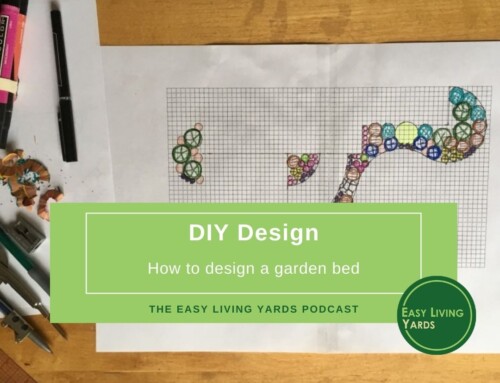

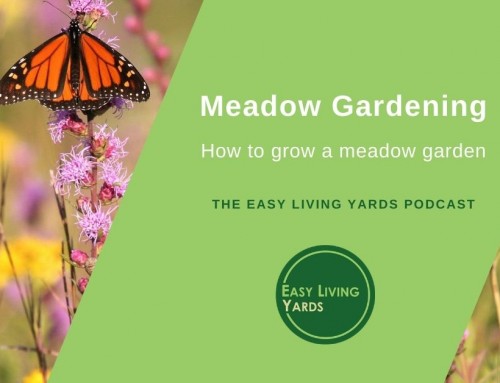
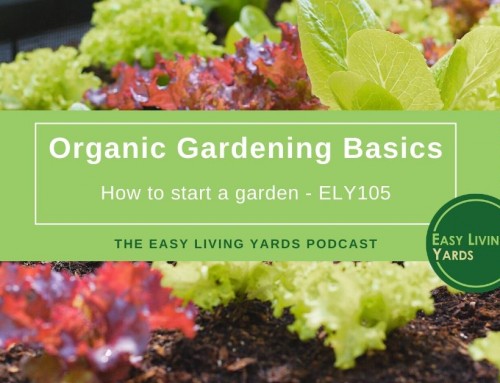
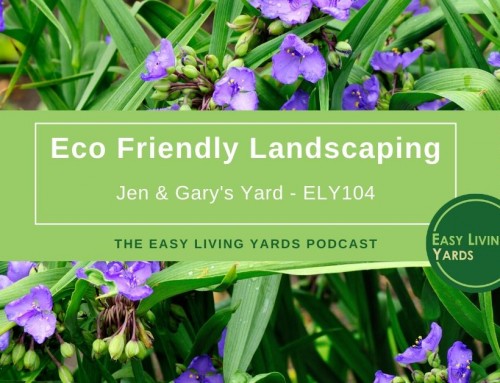

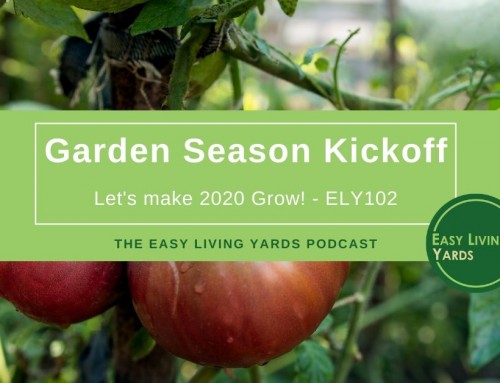
Leave A Comment